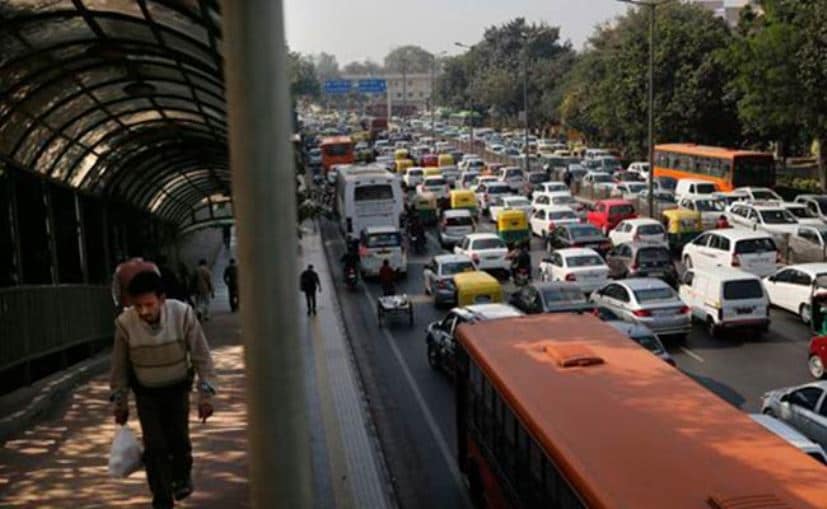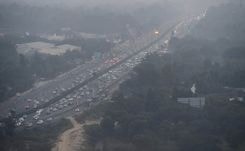US-Based Study Shows 18% Reduction in Pollutants on Odd-Even Days

In wake of the implementation of the odd-even scheme in New Delhi, most people did accept that the lack of peak-hour traffic congestion on a daily basis was a welcome change, especially for long-distance commuters. However, despite reducing the number of private cars plying on Delhi roads, absolute pollution levels have in fact gone up across NCR in January as compared to December, a stat which has led to significant concern among the masses with regards to the effectiveness of this strategy.
However, a new study jointly conducted by the Energy Policy Institute at the University of Chicago (EPIC) and the Evidence for Policy Design group from Harvard University has found that there were 'stark reductions' in pollutants at around 12pm during the odd-even scheme. As a result, the rise in absolute pollution witnessed by New Delhi itself in January was a 'smaller increase' as compared with the rest of NCR.
Every day, the 12 hours of implementation (8am to 8pm) witnessed much larger drops in pollution levels as the gap between pollution in Delhi and its surrounding areas widened steadily and continued to do so till midnight, states the study. These findings are based on data obtained from the Central Pollution Control Board and private portal, IndiaSpend.
Also Read: Odd-Even Rule: Over Rs 2 Crore Collected in Fines
When speaking with PTI, Anant Sudarshan, Director of EPIC-India, said," Particulates (PM 2.5) declined by 10-13 per cent on an average (i.e overall 24 hours) and by 18 per cent on average during the period when the scheme was in force (i.e between 8am to 8pm)." However, as was predicted, there was no effect after 8pm and hence, the daily 24-hours average was lower than the daytime average. The conclusions regarding the effectiveness of the program were drawn by comparing Delhi's air standards with those of neighbouring NCR townships like Faridabad, Noida, and Gurgaon. All these areas are geographically very similar to Delhi and feature the same weather and pollution conditions as they are 'equally exposed' to other sources of pollution like the cloud of smog created by the burning of crops in farm-rich states that surround the National Capital Region and the dust kicked up by humongous building projects.
As per Indian standards, 60ug/ cubic metre is the acceptable 'safe limit' of PM 2.5 particulates that can be present in the air. PM 2.5 is the smallest and most dangerous of all air pollutants as its 2.5micron size allows it to settle deep inside the lungs from where they are able to enter the bloodstream.
Also Read: Odd-Even Scheme May Return After March
Given the positives that have come out of the trial phase of the odd-even scheme, the Delhi government is looking to iron out a few issues with the scheme before re-applying it sometime in March-April, after school students are done with their board examinations.
Trending News
Latest News
 car&bike Team | Dec 12, 2025Nissan Entry MPV Design To Be Unveiled On December 18New MPV to be the first of three new models for India by Nissan, alongside the Tekton and a three-row SUV.1 min read
car&bike Team | Dec 12, 2025Nissan Entry MPV Design To Be Unveiled On December 18New MPV to be the first of three new models for India by Nissan, alongside the Tekton and a three-row SUV.1 min read Jaiveer Mehra | Dec 12, 2025New Mini Convertible Launched At Rs 58.50 LakhDrop-top variant of the iconic Cooper hatchback available in a single Cooper S spec.1 min read
Jaiveer Mehra | Dec 12, 2025New Mini Convertible Launched At Rs 58.50 LakhDrop-top variant of the iconic Cooper hatchback available in a single Cooper S spec.1 min read car&bike Team | Dec 12, 2025Mahindra XUV 7XO Pre-Bookings Open December 15The mid-cycle update to the XUV 700, the XUV 7XO, is set to borrow design elements and tech from the new Mahindra XEV 9S.2 mins read
car&bike Team | Dec 12, 2025Mahindra XUV 7XO Pre-Bookings Open December 15The mid-cycle update to the XUV 700, the XUV 7XO, is set to borrow design elements and tech from the new Mahindra XEV 9S.2 mins read Jafar Rizvi | Dec 12, 2025New Kia Seltos vs Maruti Suzuki Victoris: Dimensions, Engines, Features ComparedThe Seltos has long ruled the Indian market, and now it arrives with a fresh design inside and out. But, how does it compare with Maruti Suzuki’s newly launched compact SUV, the Victoris? Let’s find out.1 min read
Jafar Rizvi | Dec 12, 2025New Kia Seltos vs Maruti Suzuki Victoris: Dimensions, Engines, Features ComparedThe Seltos has long ruled the Indian market, and now it arrives with a fresh design inside and out. But, how does it compare with Maruti Suzuki’s newly launched compact SUV, the Victoris? Let’s find out.1 min read Seshan Vijayraghvan | Dec 11, 2025New MINI Cooper Convertible India Launch TomorrowThe MINI Cooper S Convertible gets a a 2.0-litre twin turbo petrol engine that makes 201 bhp and 300 Nm of peak torque.1 min read
Seshan Vijayraghvan | Dec 11, 2025New MINI Cooper Convertible India Launch TomorrowThe MINI Cooper S Convertible gets a a 2.0-litre twin turbo petrol engine that makes 201 bhp and 300 Nm of peak torque.1 min read car&bike Team | Dec 11, 2025Ather Rizta Sales Cross 2 Lakh Unit MilestoneMilestone arrives within 2 years of the scooter’s launch in April 2024.1 min read
car&bike Team | Dec 11, 2025Ather Rizta Sales Cross 2 Lakh Unit MilestoneMilestone arrives within 2 years of the scooter’s launch in April 2024.1 min read
 Janak Sorap | Dec 11, 2025Harley-Davidson X440 T First Ride Review: Smarter and SharperHarley-Davidson has taken the X440 and given it a more focused and engaging twist. The result is the X440 T—essentially the same platform but updated in areas that give the motorcycle more appeal and riders more thrill.5 mins read
Janak Sorap | Dec 11, 2025Harley-Davidson X440 T First Ride Review: Smarter and SharperHarley-Davidson has taken the X440 and given it a more focused and engaging twist. The result is the X440 T—essentially the same platform but updated in areas that give the motorcycle more appeal and riders more thrill.5 mins read Shams Raza Naqvi | Dec 10, 20252025 Mini Cooper Convertible Review: More Colour On Indian RoadsThe updated Mini Cooper Convertible is set to be launched in the Indian market in the next few days. We drive it around Jaisalmer for a quick review.1 min read
Shams Raza Naqvi | Dec 10, 20252025 Mini Cooper Convertible Review: More Colour On Indian RoadsThe updated Mini Cooper Convertible is set to be launched in the Indian market in the next few days. We drive it around Jaisalmer for a quick review.1 min read Bilal Firfiray | Dec 8, 2025Tata Sierra Review: India’s New Favourite?Marking its return after a few decades, the reborn Sierra has made everyone sit up and take notice. But is it worth the hype?10 mins read
Bilal Firfiray | Dec 8, 2025Tata Sierra Review: India’s New Favourite?Marking its return after a few decades, the reborn Sierra has made everyone sit up and take notice. But is it worth the hype?10 mins read Girish Karkera | Dec 4, 20252026 Honda Prelude First Drive: Domesticated Civic Type RA sporty-looking coupe built to give customers a taste of performance but not at the expense of everyday practicality.5 mins read
Girish Karkera | Dec 4, 20252026 Honda Prelude First Drive: Domesticated Civic Type RA sporty-looking coupe built to give customers a taste of performance but not at the expense of everyday practicality.5 mins read Seshan Vijayraghvan | Nov 29, 2025Mahindra XEV 9S First Drive Review: Big Electric SUV, Bigger ExpectationsThe XEV 9S lands at a time when the EV crowd is growing fast. It’s a big, born-electric, three-row SUV that starts under 20 lakh. It sits close to the XUV700 in size, but the brief is very different. Here’s what it’s like on the road.11 mins read
Seshan Vijayraghvan | Nov 29, 2025Mahindra XEV 9S First Drive Review: Big Electric SUV, Bigger ExpectationsThe XEV 9S lands at a time when the EV crowd is growing fast. It’s a big, born-electric, three-row SUV that starts under 20 lakh. It sits close to the XUV700 in size, but the brief is very different. Here’s what it’s like on the road.11 mins read

































































































































